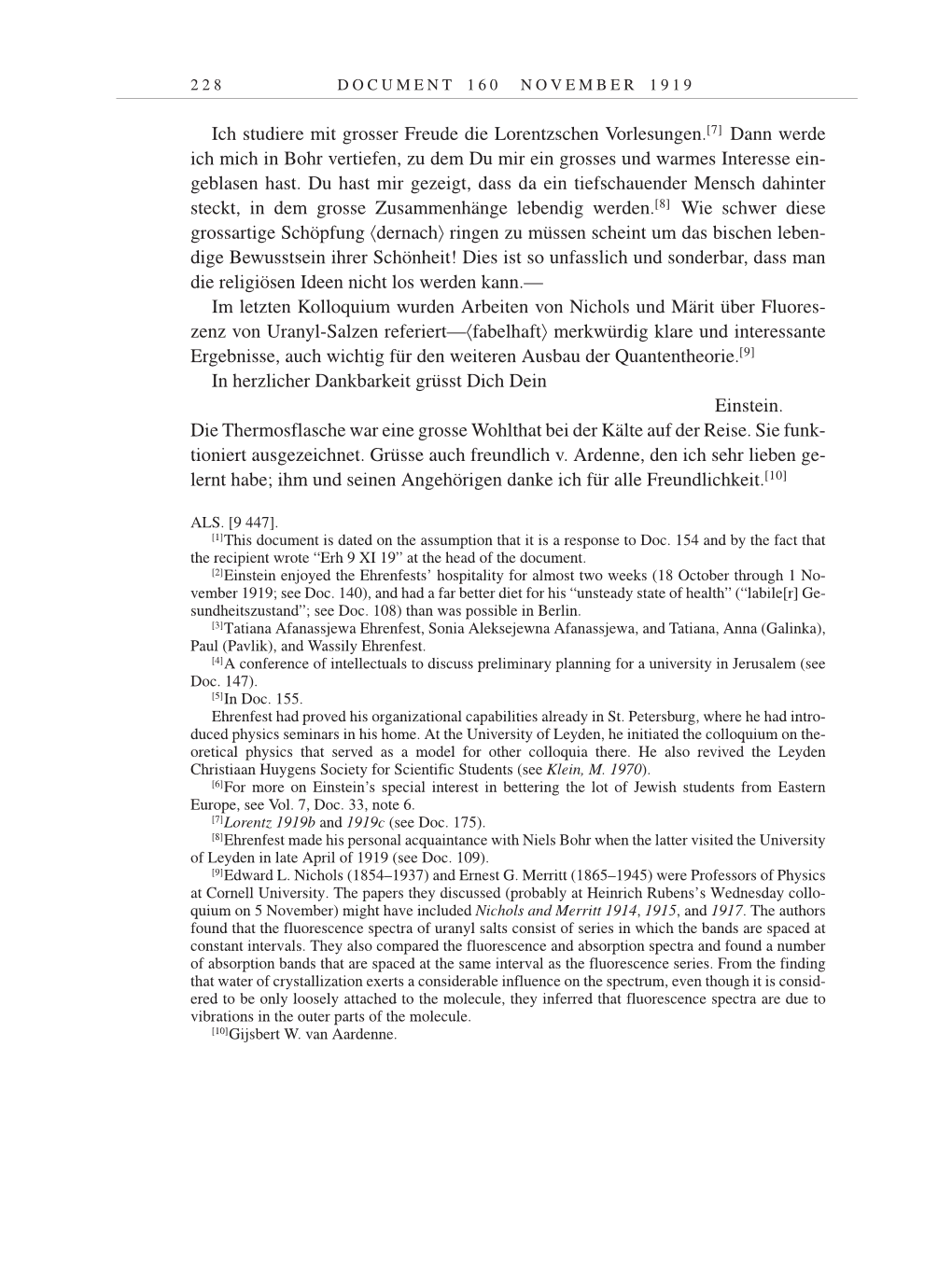2 2 8 D O C U M E N T 1 6 0 N O V E M B E R 1 9 1 9
Ich studiere mit grosser Freude die Lorentzschen
Vorlesungen.[7]
Dann werde
ich mich in Bohr vertiefen, zu dem Du mir ein grosses und warmes Interesse ein-
geblasen hast. Du hast mir gezeigt, dass da ein tiefschauender Mensch dahinter
steckt, in dem grosse Zusammenhänge lebendig
werden.[8]
Wie schwer diese
grossartige Schöpfung 〈dernach〉 ringen zu müssen scheint um das bischen leben-
dige Bewusstsein ihrer Schönheit! Dies ist so unfasslich und sonderbar, dass man
die religiösen Ideen nicht los werden kann.—
Im letzten Kolloquium wurden Arbeiten von Nichols und Märit über Fluores-
zenz von Uranyl-Salzen referiert—〈fabelhaft〉 merkwürdig klare und interessante
Ergebnisse, auch wichtig für den weiteren Ausbau der
Quantentheorie.[9]
In herzlicher Dankbarkeit grüsst Dich Dein
Einstein.
Die Thermosflasche war eine grosse Wohlthat bei der Kälte auf der Reise. Sie funk-
tioniert ausgezeichnet. Grüsse auch freundlich v. Ardenne, den ich sehr lieben ge-
lernt habe; ihm und seinen Angehörigen danke ich für alle
Freundlichkeit.[10]
ALS. [9 447].
[1]This document is dated on the assumption that it is a response to Doc. 154 and by the fact that
the recipient wrote “Erh 9 XI 19” at the head of the document.
[2]Einstein enjoyed the Ehrenfests’ hospitality for almost two weeks (18 October through 1 No-
vember 1919; see Doc. 140), and had a far better diet for his “unsteady state of health” (“labile[r] Ge-
sundheitszustand”; see Doc. 108) than was possible in Berlin.
[3]Tatiana Afanassjewa Ehrenfest, Sonia Aleksejewna Afanassjewa, and Tatiana, Anna (Galinka),
Paul (Pavlik), and Wassily Ehrenfest.
[4]A conference of intellectuals to discuss preliminary planning for a university in Jerusalem (see
Doc. 147).
[5]In Doc. 155.
Ehrenfest had proved his organizational capabilities already in St. Petersburg, where he had intro-
duced physics seminars in his home. At the University of Leyden, he initiated the colloquium on the-
oretical physics that served as a model for other colloquia there. He also revived the Leyden
Christiaan Huygens Society for Scientific Students (see Klein, M. 1970).
[6]For more on Einstein’s special interest in bettering the lot of Jewish students from Eastern
Europe, see Vol. 7, Doc. 33, note 6.
[7]Lorentz 1919b and 1919c (see Doc. 175).
[8]Ehrenfest made his personal acquaintance with Niels Bohr when the latter visited the University
of Leyden in late April of 1919 (see Doc. 109).
[9]Edward L. Nichols (1854–1937) and Ernest G. Merritt (1865–1945) were Professors of Physics
at Cornell University. The papers they discussed (probably at Heinrich Rubens’s Wednesday collo-
quium on 5 November) might have included Nichols and Merritt 1914, 1915, and 1917. The authors
found that the fluorescence spectra of uranyl salts consist of series in which the bands are spaced at
constant intervals. They also compared the fluorescence and absorption spectra and found a number
of absorption bands that are spaced at the same interval as the fluorescence series. From the finding
that water of crystallization exerts a considerable influence on the spectrum, even though it is consid-
ered to be only loosely attached to the molecule, they inferred that fluorescence spectra are due to
vibrations in the outer parts of the molecule.
[10]Gijsbert W. van Aardenne.
